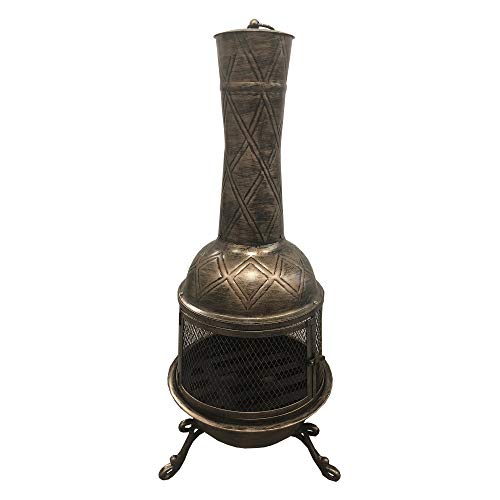The Most Underrated Companies To Follow In The Ceramic Chiminea Indust…

Alda
2024-09-20 14:16
14
0
본문
 The Basics of a Ceramic Chiminea
The Basics of a Ceramic ChimineaClay is the most popular material used to make chimineas. Think of terracotta chiminea pots, or red pottery. Clay is tough and durable but it can also crack if handled improperly.
The chiminea's clay is highly absorbent and needs to be protected with gravel or sand at the bottom of the chiminea, along with logs and kindling. This stops the clay from becoming too hot and closes any hairline cracks.
Materials
The traditional clay chimineas (also known as pot-bellied or ovens) include a chimney that emits smoke upwards. These types of chimineas are usually glazed to protect them from weathering and cracking due to abrupt temperature fluctuations. They are still vulnerable to sunlight and rain. This is why it is important to cover them when not in use and to ensure that no water puddles form within the clay.
The majority of Chimineas Near me are constructed from terracotta clay, although other materials like cast iron and steel chiminea are also readily available. Aluminum and cast iron offer a durable option that requires less maintenance. Terracotta has a classic Mexican style. Some manufacturers offer modern styles that combine the beauty and durability of a chiminea made of clay.
Many people opt to pair their chimineas with flowers or evergreens. This gives a natural appearance to complement the ambiance in their backyard. It is important to choose plant pairings carefully, though, as a chiminea needs to be placed in an area that is free of overhead structures that could catch fire. It is also essential to ensure that the chiminea's location is on a safe surface such as concrete, brick or stone patios.
Chiminesas can be created by hand using high-fired, unglazed clay. The person who creates the clay is known as a potter, and they can throw the piece on a potter's wheel, or using a mould made of plaster. In either case, the clay is kneaded before it is allowed to dry. Some of the more recent clay chimineas have been pre-grogged. This is a compound which can help to resist thermal stress that is susceptible to cracking earthenware.
Other chimineas are made in molds made of metal, which gives the chimineas a variety of design and shape that can be adapted to any backyard. cast iron chiminea iron chimineas are heavier than clay versions, but they are more durable to the elements and aren't as prone to cracking or breaking due to sudden temperature changes like clay. They are less expensive than other types of chimineas as well, and they come with gas-burning models too to give you more versatility.
Styles
A chiminea is designed to resemble an outdoor fireplace, and can be decorated with a variety of materials and styles. Terracotta chimineas offer the classic design that dates back centuries, while metal alternatives are more durable and be able to withstand high temperatures. Many chimineas feature designs and patterns that enhance the patio furniture. A rustic finish, for example can give your chiminea a vintage feel, especially if you pair it with wood or iron patio furniture.
Chimineas are usually designed to be freestanding, but they may also be mounted on a stone, brick or concrete patio. No matter where you choose to place your chiminea, pick a spot that is safe from winds and positioned away from any flammable plants or structures. It is important to remember that chimineas release smoke and soot, which can affect the air quality of the surrounding area.
Certain chimineas have a chimney opening at the bottom, whereas others are squat with an upwards-facing point. Both designs have an opening that is large enough to accommodate firewood. The chimneys on squat models are capable of being designed to give them a a more dramatic appearance and enhance the visual appeal.
You can also include decorative elements on the outside of your chiminea, such as wrought iron, granite, or marble. Think about a copper or ceramic top to add a bit of style. The shiny shine of these finishes help to reflect the light from your fire and enhances the overall appearance of your chiminea.
Regular chiminea polishing is another method to enhance the appearance of your fire pit outside and shield it from damage. Utilize a natural polishing solution like beeswax or olive oil, to smooth the surface and create an intense glow. Apply a thin coat and rub gently before rinsing and drying the chiminea to get a stunning result.
Chimineas require a lot of work, but with the right care and care your outdoor chiminea will be fashionable for many years. With the help of efficient decorating and maintenance strategies, you can enjoy your backyard chiminea well into the cooler months.
Safety
Although chimineas are a popular choice but they can be dangers to safety if they are not correctly used. Chimineas made of clay are susceptible to cracking, particularly those that aren't glazed. They also pose a fire risk when placed too close to other flammable materials, including your home, outdoor furniture and the garden surrounding it. You should only use a chiminea outside and in an area that is fenced or surrounded by fire pits chimineas-safe materials.
It is recommended to keep a fire extinguisher close by and use it to extinguish small fires or hot coals that arise while you tend to the flame. It is also a good idea to make use of a long lighter to light the fire and move coals around using tongs rather than with your hands. It is also a good idea to keep an extra bucket of water in the vicinity in case you need to extinguish the chiminea indoor. However, it is essential to never use water to extinguish the chiminea that has been cool and to only add water after the fire has died naturally or if a large fire is in danger of bursting into the chimney.
The draft that is created by a chiminea could send sparks upwards through the stack, and it is crucial to safeguard your property and your neighbors from burns that could happen accidentally by using simple spark arrestors constructed from chicken wire placed around the top of the smokestack. Chimineas also generate a lot of heat and the surrounding area can get extremely hot, so you should place a low wall around the chiminea in order to remind people that getting too close to it could result in painful burns.
Never burn your chiminea during stormy or rainy weather. The sparks can cause a chimney to catch on fire, which could cause damage to your home. Before you use a chiminea, check with the local fire department to confirm that there aren't any burning bans in place. You should also clear the area around the chiminea before adding firewood, ensuring that there aren't any objects that could ignite nearby. Also, you should clean the interior of your fireplace after every use. This will prevent the accumulation of ash, which can cause smoke inhalation or even a sooty outside.
Maintenance
Despite the fact that they can be used for outdoor fires, clay chimineas are not care-free devices. To ensure their durability they should be treated exactly the same way as all clay products. It is crucial not to allow them to get too hot and allow them to cool between use. Furthermore they should be frequently sanded and sealed to keep the paint from being damaged by moisture.
The first step to keep your chiminea in good shape is to remove the ashes from it after each use, but only once the chiminea has completely cool down. It will be warm, even if it appears to have cooled down, so use the smallest rake and brush to get rid of the ash. After you have cleaned the ash off and disposed of it carefully, the next step is to fill the bottom with either gravel or sand. This is crucial, as if you do not do this, the chiminea may crack. The clay absorbs moisture and can crack when it becomes too dried.
Some sources suggest sealing the exterior of the chiminea by using an acrylic waterproofing agent similar to those used to seal tiles. This can prevent moisture from seeping into the chiminea and damaging it. It is recommended that the chiminea gets sanded and resealed every 6 to 8 weeks during times of heavy use.
Chimineas must only be used on surfaces free of wood or other coverings. Using only well-seasoned hardwood can also decrease the number of sparks that are produced and prevent cracking the clay.
A chiminea made of clay won't last for a long time. However it is very not a problem to break unless smash it with the force of a Hammer. Cracks can occur for a variety of reasons, such as poor burning and a lack of maintenance. They are also prone to rust, which is why they must be covered when not in use. This will keep snow and rain from it, ensuring that it will not start to corrode the metal parts of the chiminea.


댓글목록0
댓글 포인트 안내